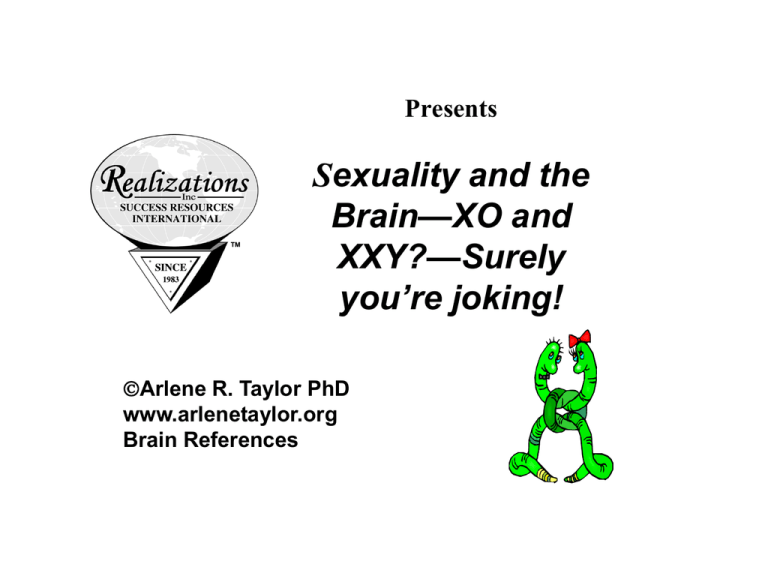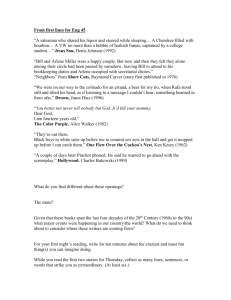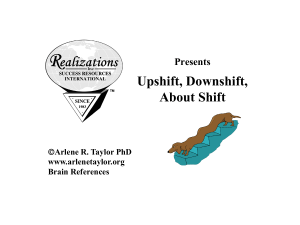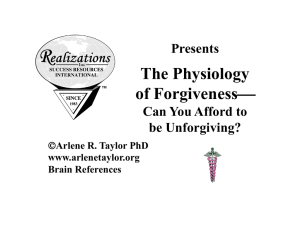Presents Male-Female Differences – Understanding Gender
advertisement

Presents Sexuality and the Brain—XO and XXY?—Surely you’re joking! Arlene R. Taylor PhD www.arlenetaylor.org Brain References “It would appear that in most cases life is sexually transmitted…” Remember Arlene R. Taylor PhD Realizations Inc Whatever else human beings are, they are relational, spiritual, and sexual (whether or not they engage in sexual activity) The brain is your primary sex organ – sex begins and ends in the brain Sexuality impacts every aspect of life, personal, professional— at home, school, church, work, play … Nature plus Nurture Arlene R. Taylor PhD Realizations Inc Humans are a combination • Nature: genetics – genes, chromosomes, DNA • Nurture: epigenetics – environment, hormones, cellular memory, gene expression But it is complex and not as fool-proof and straightforward as one might think Human Genome Arlene R. Taylor PhD www.arlenetaylor.org Your complete set of genetic information encoded within 23 pairs of chromosomes in the cell nucleus (plus cellular memory in protein strands) A chromosome is a single piece of coiled DNA, a biomolecule that holds the blueprint for how living organisms are built - 99% of all DNA (deoxyribonucleic acid) in your body is found in chromosomes Chromosomes Arlene R. Taylor PhD Realizations Inc Pairs 1-22 are numbered by size and appearance – normally the same in males and females The 23rd pair = sex chromosomes Sex Chromosomal Patterns Arlene R. Taylor PhD Realizations Inc Typical female pattern: Typical male pattern: 44 + XX 44 + XY Ovum – largest human cell Sperm – smallest human cell Default Setting Arlene R. Taylor PhD Realizations Inc All fetal brains start out looking very similar Without a chemical bath, the brain’s default position will result in an Empathizing (female) brain that sprouts more connections in centers related to communication and to the processing of emotions Templating & Variations Arlene R. Taylor PhD Realizations Inc When everything goes according to to the perceived schedule, the brain develops and templates as expected by family, society, culture, religion, and etc. Either a primarily Systemizing or Empathizing brain in which the brain matches its body housing Templating mismatches (variations) do occur Hormonal impact: Brain doesn’t always match its body housing regardless of chromosome patterns Gender Brain Continuum Arlene R. Taylor PhD Empathizing Brain Equated more with female brains – XX XO, XXX 50-50 Intersex Brain XX XY Realizations Inc Systemizing Brain Equated more with male brains – XY XXY, XXXY, XXXXY Includes 95% of the population Checklists of psychological maleness or femaleness give two scores (no one is completely empathizing or systemizing) “We Have Chemistry!” Arlene R. Taylor PhD Realizations Inc When you and a romantic partner “have chemistry” – you're right! Neurochemistry triggers sweaty palms, butterflies in your stomach, a sense of attachment / anxiety / excitement / anticipation, and so on That’s all it is: Brain Neurochemistry Hijacked Brain Arlene R. Taylor PhD Realizations Inc Your brain is the most outstanding organ on this planet It works 24 hours a day, 365 days a year, from birth—until you fall in romantic love Then it gets hijacked by PEA or phenylethylamine and you become a Pea Brain Brain Chemicals Arlene R. Taylor PhD Realizations Inc Falling in romantic love or being in love is fueled by a tsunami of at least three neurochemicals: 1. Phenylethylamine 2. Norepinephrine 3. Dopamine Without this chemical impetus many likely would never marry or have children . . . 1. Phenylethylamine or PEA Arlene R. Taylor PhD Realizations Inc PEA is a naturally occurring neurotransmitter that resembles an amphetamine (stimulant); it triggers the release of norepinephrine and dopamine It is also found in some foods such as chocolate and avocado PEA is responsible for the elation and head-over-heels sensations associated with falling in love Addicted to PEA … Arlene R. Taylor PhD Realizations Inc The couple may not make it past the PEA brain stage (if sexually active, PEA may last a little longer) Some move from one relationship to another as soon as PEA begins to fall— seeking that passionate PEA brain stage If they marry, one or both may have extramarital affairs trying desperately to re-experience that romantic hormonal tsunami 2. Norepinephrine (Noradrenaline) Arlene R. Taylor PhD Realizations Inc Both a hormone and a neurotransmitter, it works with the autonomic nervous system (acts largely unconsciously) and regulates sexual arousal PEA triggers the release of norepinephrine, you feel the effects in the form of sweaty palms and a pounding heart 3. Dopamine: Feel-better Hormone Arlene R. Taylor PhD Realizations Inc Dopamine is released when you feel or anticipate feeling better (50% is in the GI) Release is triggered by phenylethylalanine, adrenalin, and by sexual activity Emory University: voles (a rodent) chose their mate based on dopamine release when female voles were injected with dopamine in the presence of a male vole, they later selected him from a group “Honeymoon” . . . Arlene R. Taylor PhD Realizations Inc Chemically speaking, the honeymoon is over, about 18 – 48 months into a relationship (especially if relationship includes sexual activity) You may have some small neurochemical tsunamis but rarely like it “used to be” – so grow up, get over it, and work on building the relationship (Hollywood relationships . . .) Unconditional Love Arlene R. Taylor PhD Realizations Inc Unconditional love is a choice and requires maturity, constant nurturing, and commitment Relationships that last longer than 18-48 months are assisted by three other (different) neurochemicals: 1. Oxytocin 2. Serotonin 3. Endorphins 1. Oxytocin – Bonding Hormone Arlene R. Taylor PhD Realizations Inc Plays a role in the neuroanatomy of intimacy, pair bonding (sexual activity increases oxytocin) and maternal behaviors Oxytocin crosses the BBB but is destroyed in the GI Tract Evokes a sense of contentment, reduction in anxiety and stress, promotes feelings of calmness and security when in the company of the mate, and allows orgasm to occur 2. Serotonin Arlene R. Taylor PhD Realizations Inc A neurotransmitter found primarily in the brain and central nervous system or CNS and in the gastrointestinal tract (90%) It is believed to impact mood and has been found to contribute to feelings of well-being and happiness Increases with mild to moderate physical exercise 3. Endorphins – Brain Opiates Arlene R. Taylor PhD Realizations Inc As the brain develops tolerance to “love chemicals,” it starts to release endorphins— produced during exercise, love, and sexual activity Endorphins can calm anxiety, reduce stress, relieve pain, and increase attachment and comfort Attraction Arlene R. Taylor PhD Notices first the person’s clothes, eyes, and figure Appreciation of sex partner is more romantic than sexual Attracted to wealth, position, skill, and see possibilities Realizations Inc Attracted first to looks (figure, face, clothing) Decide in about seven seconds if they want to get better acquainted More aggressive and fall in love faster (25% by first date) Socialization Differences Arlene R. Taylor PhD Realizations Inc Males are encouraged to sow their wild oats; females are not and there is more censure for female sexuality Even in the era of “free love,” promiscuity is accepted as more of a male norm Some cultures: females are encouraged to LOOK sexual (arm candy for male partner) but then punished emotionally if they respond to flirting Think Ahead Arlene R. Taylor PhD Realizations Inc To compensate for the hormonal tsunami that hits you when you’re “in love” • Be clear about your standards • Identify key characteristics for a partner • Be the type of person you want to attract • Do you want that individual as the parent of your child(ren)? Think Ahead, Cont’d Arlene R. Taylor PhD Realizations Inc • Get to know the family—do you want them as relatives for your child? • The more you have in common, the less energy it will require to keep the relationship going • Trying to change someone is a dead end street • The past is the best predictor of the future The Best and the Worst Arlene R. Taylor PhD Realizations Inc Where there is an ongoing relationship of caring. Where there is a sense of humor. Where there is a sense of mutual mercy. Where there is a sense that God has given sex to you . . . there is nothing livelier. But when it is merchandised as a commodity for instant gratification, there is nothing deadlier than sex. ―William Swing (Your body is a temple…) Know Better – Do Better Arlene R. Taylor PhD Realizations Inc It is not that I do not know what to do; it is that I do not do what I know. –Confucius By itself, knowing is insufficient Knowing must be practically applied by choice in doing . . . What do you know and what do you do?


